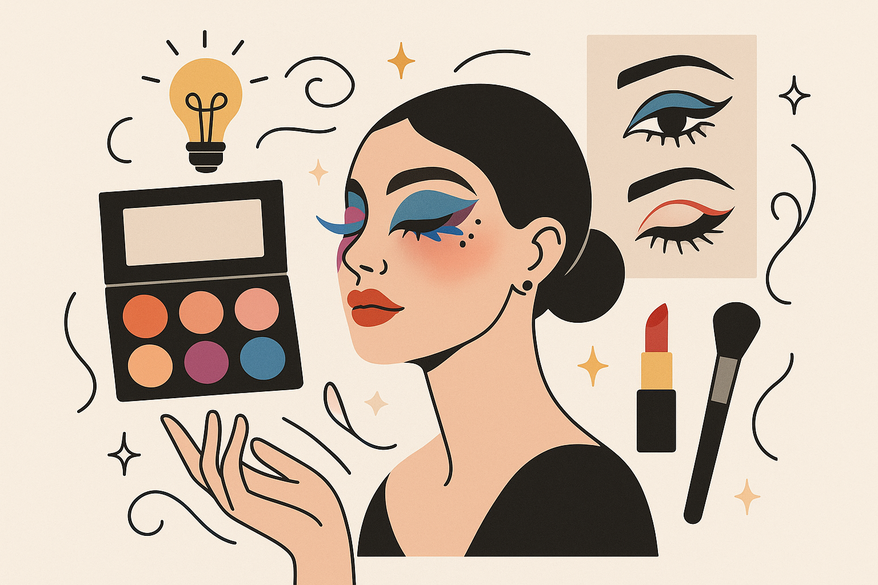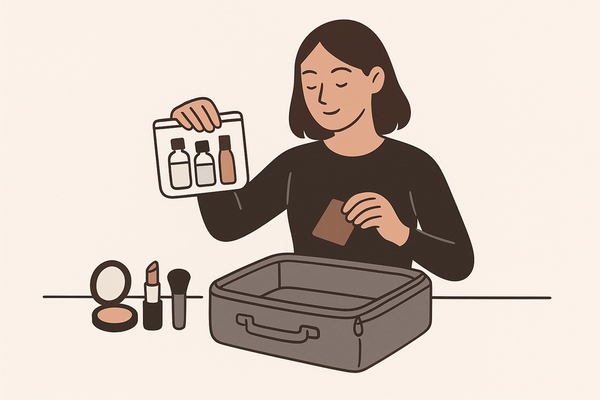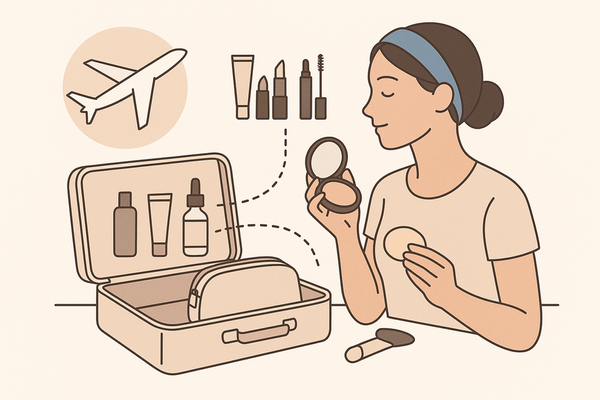Express Yourself: The Ultimate Guide to Creative Makeup Designs
Discover the world of creative makeup designs with our guide on styles, techniques, and inspiration. Transform your look and express your artistry.

Estimated reading time: 10 minutes
Key Takeaways
- Creative makeup transforms skin into a canvas, blending history and innovation.
- Social media platforms like Instagram and TikTok have democratized avant-garde face art.
- Styles range from fantasy and thematic to sculptural avant-garde and detailed face painting.
- Master blending, contouring, color theory, and layering for striking results.
- Essential tools include specialized brushes, sponges, stencils, pigments, and special effects supplies.
- Follow a clear step-by-step tutorial—such as the rainbow graphic liner look—to build confidence.
- Draw inspiration from pioneers like Pat McGrath, Alex Box, and Mimi Choi, and join vibrant online communities.
Table of Contents
- Introduction
- The Evolution and Importance of Creative Makeup Designs
- Key Styles and Categories in Creative Makeup Designs
- Techniques and Tips for Achieving Creative Makeup Designs
- Tools and Products Essential for Creative Makeup Designs
- Step-By-Step Tutorial: Rainbow Graphic Liner Look
- Inspiring Artists and Trends in Creative Makeup Designs
- Conclusion & Call to Action
- FAQ
Introduction
Creative makeup designs have exploded in popularity across social media and fashion runways. These inventive looks use bold hues, striking patterns, and textured accents to turn the face and body into living art. At its core, creative makeup design is a visually imaginative, unconventional application that transforms skin into a canvas for self-expression.
Over the last decade, platforms like Instagram and TikTok have fueled this art form’s rise, with artists sharing tutorials and stunning before-and-after shots. Ready to explore creative designs in a new way? Harness AI-powered inspiration with Makeup Check AI for instant face art ideas and personalized feedback.
Section 1: The Evolution and Importance of Creative Makeup Designs
Sub-section A: Ancient Origins of Creative Makeup Designs
Early humans saw makeup as more than beauty. In ancient Egypt, both men and women painted eyes with kohl to ward off the sun’s glare and signal social rank. Mineral pigments in green, red, and blue marked ceremonies, rituals, and daily life. This body art symbolized protection, power, and identity in early civilizations. Learn more in 4000 Yrs of Makeup – The Evolution of Makeup.
Sub-section B: 18th–19th Centuries of Creative Makeup Designs
In 1700s Europe, theatrical and aristocratic circles turned makeup into spectacle. White lead face paint and bright rouge signaled wealth. Stage actors used face paint to communicate characters to distant audiences. By the 1800s, powdered cheeks and painted lips appeared in salons and opera houses, linking makeup to class and performance. Discover more at The Strange and Exciting History of Makeup.
Sub-section C: 20th Century to Present for Creative Makeup Designs
The 1900s introduced mass-produced compacts, lipstick tubes, and influencer faces. Hollywood stars like Elizabeth Taylor set eye-makeup trends. In the 1960s, Twiggy’s graphic liner inspired pop-art faces. Runways in the 2000s embraced avant-garde twists—geometric shapes, metallic finishes, and extreme lashes. Today’s experimental looks draw on decades of innovation. Read on Evolution of Makeup Eye Looks Through History.
Sub-section D: Cultural & Social Impact Today of Creative Makeup Designs
Modern creative makeup designs thrive in festivals, activism, and digital communities. Pride parades feature rainbow face paint. Indigenous art revives with ceremonial body painting. Makeup artists use TikTok and Instagram Reels to demo 3D gels, face jewels, and duochrome pigments. Social media democratizes art, letting beginners and pros share, remix, and inspire. Explore the Evolution of Eye Makeup Trends.
Section 2: Key Styles and Categories in Creative Makeup Designs
Creative makeup designs span a range of styles:
- Fantasy Makeup
Mythical motifs—unicorn horns, mermaid scales, fairy wings
Tip: Use 3D gels and lash gems for a magical glow. - Avant-Garde Makeup
Couture editorials—sculpted forms and abstract shapes
Tip: Experiment with silicone appliqués and molded wax. - Thematic Makeup
Holiday or pop-culture looks—Halloween zombies, film heroes
Tip: Combine face paint with foam props to build costume synergy. - Artistic Face Painting
Intricate illustrations—mandalas, optical illusions, graphic art
Tip: Fine brushes and water-activated palettes ensure crisp lines.
Visual inspiration floods social feeds, from 3D illusion art to floral watercolor effects. Search hashtags like #FaceArt or #CreativeMakeupDesigns for ideas. Explore avant-garde trends in creative face art and get AI-powered design inspiration.
Section 3: Techniques and Tips for Achieving Creative Makeup Designs
- Blending
Soft, circular strokes to merge colors seamlessly. Tool: Synthetic blending brush for even gradients. - Contouring & Sculpting
Strategic placements of light and dark to shape or exaggerate features. Tip: Layer cream contour under powder for extra dimension. - Color Selection & Theory
Choosing palettes—complementary (opposites) vs. analogous (adjacent). Tip: Test shades on white paper to judge true tone. - Layering
Building depth with cream over powder, then adding glitter or pigment. Tip: Set each layer with translucent powder or makeup fixative. - Advanced Elements
Prosthetics or mixed media—feathers, sequins, lace accents. Always prioritize skin safety: patch-test adhesives and fixatives.
Precision tools like fine liners, silicone applicators, and high-pigment creams are vital for detail work. Set finished designs with a spritz of setting spray to lock colors in place.
Section 4: Tools and Products Essential for Creative Makeup Designs
To build your makeup art kit, start with these essentials:
- Brushes
- Flat Shader Brush – Pat on color without streaks
- Angled Liner Brush – Create sharp lines and geometric shapes
- Detail Brush – Paint fine designs, dots, and thin patterns
- Fan Brush – Sweep off fallout, dust on highlights
- Blending Brush – Soften edges and merge hues
- Sponges
- Beauty Blender – Smooth, streak-free foundation and cream layers
- Silicone Sponge – Spread color without absorbing product
- Stencils & Masks
Use for repeated motifs or crisp edges. Tip: Secure with light tape before painting. - Bases & Foundations
Full-coverage, pigmented formulas create a flawless canvas. White or black cream bases help colors pop. - Color Products
- Vibrant Eyeshadow Palettes – Rich pigments for bold contouring
- Cream Paints – High-impact, blendable bases for face art
- Water-Activated Palettes – Mix with water for sheer or opaque effects
- Special Effects
- Adhesives – Lash glue for gems and small prosthetic pieces
- Loose Glitters – Press onto tacky primer for sparkle
- Prosthetics – Silicone and latex pieces for 3D details
Top Brand Picks
Kryolan – Theatrical wear with extreme longevity
Mehron – Face/body paints with skin-safe formulas
Anastasia Beverly Hills – Ultra-pigmented eyeshadow palettes
Section 5: Step-By-Step Tutorial: Rainbow Graphic Liner Look for Creative Makeup Designs
Step 1: Prep Skin
Moisturize and apply a pore-filling primer to create a smooth base.
Step 2: Neutral Base
Sweep a skin-tone or white eyeshadow primer across lids to ensure color fidelity.
Step 3: Color Placement
Using an angled brush, draw six arched lines above the crease in ROYGBV order (red, orange, yellow, green, blue, violet). Keep each arc thin and evenly spaced.
Step 4: Clean-Up
Dip a pointed concealer brush into foundation to correct stray marks.
Step 5: Contrast
Layer white eyeliner highlights or black liner under each color to make them pop.
Step 6: Finish
Set the liner with clear mascara on lashes or a light spritz of setting spray. Optional: Press a fine glitter topper along the top of the liner for extra shimmer.
Further Learning Resources
James Charles YouTube Rainbow Liner Tutorial
NikkiTutorials TikTok Graphic Liner Reels
MasterClass and Udemy Courses on Avant-Garde Makeup
Section 6: Inspiring Artists and Trends in Creative Makeup Designs
Artist Spotlight
Pat McGrath – Pioneer of sculptural, haute-couture editorials, known as the “Mother of Makeup.”
Alex Box – Surreal mixed-media transformations that blur face and art.
Mimi Choi – Optical illusion makeup that defies perception and challenges reality.
Social Media Movements
#FaceArt on Instagram – Over 5 million posts showcasing elaborate designs.
TikTok Trends – Duochrome cheeks, extreme ombré lips, and psychedelic swirl effects.
Join the Community
Tag your creations with #CreativeMakeupDesigns or #YourBrandArtistry. Follow these artists for daily inspiration and technique breakdowns.
Conclusion & Call to Action
Creative makeup designs blend history, innovation, and personal expression. From ancient kohl lines to TikTok’s neon wave, makeup art has evolved into a boundary-pushing medium. You now have the tools, techniques, and inspiration to explore fantasy, avant-garde, thematic, or illustration-style looks.
Dive in and experiment—there are no rules, only possibilities. Share your latest creative makeup designs on Instagram using #YourBrandArtistry or join our private Facebook group for feedback and community support. We can’t wait to see your masterpiece!
FAQ
- How do I start learning creative makeup designs?
Begin with basic blending and color theory tutorials, then practice small motifs like graphic liner or simple face painting before moving on to more elaborate designs. - What are must-have tools for face art?
Essential items include a variety of brushes (shader, liner, detail), sponges or beauty blenders, quality pigments, and setting spray. Stencils and fine liners add precision. - How can I ensure safe application with prosthetics and adhesives?
Always perform a patch test with any adhesive or fixative on a small area of skin. Use skin-safe products labeled for cosmetic use, and remove gently with an appropriate remover. - Where can I find inspiration and share my designs?
Explore hashtags like #FaceArt and #CreativeMakeupDesigns on Instagram or TikTok. Join forums and Facebook groups dedicated to makeup artistry for feedback and support.




